Business
Marketing on a Shoestring Budget: Proven Strategies That Work
Discover effective strategies for marketing on a shoestring budget that can elevate your brand—what will you implement first?

Marketing on a shoestring budget requires some smart strategies that can stretch every dollar. Start by leveraging customer referrals, as 83% of people trust personal recommendations over ads. Engage your audience through social media by incorporating user-generated content to boost authenticity. You can also utilize email marketing to segment your audience and personalize your outreach, increasing engagement. Don't forget to take part in local events to connect with your community and build brand visibility. Each of these strategies can help you create an impactful marketing plan without overspending, and there's plenty more insight to explore on making your efforts shine.
Key Takeaways
- Leverage user-generated content on social media to enhance authenticity and increase engagement without significant investment.
- Utilize email marketing with audience segmentation to improve open rates and engagement while keeping costs low.
- Engage in community involvement through local events and charitable collaborations to boost visibility and brand loyalty.
- Repurpose existing content into various formats like infographics or videos to maximize reach and SEO benefits at minimal cost.
- Implement a structured feedback loop to gather insights and promptly address client concerns, fostering satisfaction and referrals without heavy expenditure.
Client Communication Strategies

Effective client communication strategies can make all the difference in building lasting relationships. One of the simplest yet most effective methods is sending personalized emails and making phone calls. This approach not only keeps your brand fresh in your clients' minds but also greatly enhances client retention rates.
Regular check-ins can lead to a whopping 25% increase in upselling opportunities, showing that attentiveness pays off. Additionally, understanding IRA Investment Strategy can help tailor your communication to address specific client needs in a more focused manner.
You'll find that consistent communication builds trust and confidence, strengthening your relationships. When clients feel valued, they're more likely to refer you, boosting your credibility.
Establishing a routine for reaching out can also raise your response rates; studies indicate personalized communication can improve engagement by up to 50%.
Moreover, implementing a structured feedback loop allows you to address client concerns swiftly. This adaptability fosters a culture of continuous improvement and enhances client satisfaction.
Leveraging Customer Referrals

When it comes to marketing, trust is everything, and customer referrals tap into that trust like nothing else. By encouraging word-of-mouth and utilizing testimonials effectively, you can turn satisfied customers into your best advocates.
To enhance your referral strategy, consider creating curated gift boxes that resonate with your customers' interests, similar to the way heartwarming gift boxes can evoke positive emotions. Not only does this approach boost your credibility, but it can also considerably increase your sales without breaking the bank.
Importance of Trust
Trust plays an essential role in leveraging customer referrals, as people are more likely to believe recommendations from friends and family than any advertisement. In fact, 83% of consumers trust these personal referrals, which means your existing customers can be your best marketing asset.
By cultivating strong relationships with them, you not only enhance their loyalty but also open the door to new leads. This is similar to the way fathers nurture and guide their children, allowing them to thrive and succeed in life, as seen in inspirational quotes about fatherhood.
Businesses that actively encourage referrals see a 70% higher conversion rate, emphasizing the effectiveness of word-of-mouth marketing. When you ask satisfied customers to share their experiences, you tap into a powerful channel for customer acquisition.
Additionally, positive reviews greatly boost your credibility; 72% of consumers say they trust brands more when they see glowing testimonials.
Integrating customer feedback into your marketing strategies can further enhance this trust. With approximately 92% of consumers trusting referrals from people they know, it's clear that building a community of loyal customers can lead to considerable growth.
Encouraging Word-of-Mouth
Word-of-mouth is a powerful marketing tool that can greatly boost your business without requiring a hefty budget. By encouraging referrals from satisfied customers, you can tap into a source that accounts for 20-50% of purchasing decisions. People trust recommendations from friends and family over any advertisement, making word-of-mouth a critical component of your marketing strategies.
Additionally, providing high-quality products, like those from trusted brands in the pet food industry, can enhance customer satisfaction and lead to more referrals high-quality protein sources.
To effectively leverage this resource, consider the following approaches:
- Implement a referral program: Incentivize your current customers to share your brand. This can increase customer acquisition rates by up to 25%.
- Engage with your customers: Ask for referrals directly after a positive experience. Make it easy for them to share your services with their networks.
- Showcase customer testimonials: Highlight positive feedback from clients. With 70% of people trusting online reviews as much as personal recommendations, showcasing testimonials can enhance your brand's credibility.
Utilizing Testimonials Effectively
Utilizing testimonials effectively can transform your marketing strategy and greatly enhance your brand's credibility. With 72% of consumers indicating that positive testimonials boost their trust in a business, leveraging these powerful endorsements is a no-brainer.
By focusing on relatable themes and character-driven narratives, as highlighted in plot ideas that print money, you can encourage satisfied clients to share their experiences, as referrals can lead to a remarkable 50% increase in sales, proving that consumer trust is paramount.
Incorporate testimonials into your website to improve conversion rates by up to 34%. They act as social proof, validating the quality of your products or services.
Don't underestimate the impact of video testimonials either; 64% of consumers are more likely to purchase after watching a video review. These dynamic testimonials engage potential customers and create a stronger emotional connection.
Additionally, actively soliciting feedback through surveys and polls not only offers valuable insights for improvement but also provides opportunities to gather testimonials for future marketing efforts.
Engaging on Social Media

Engaging on social media is all about building connections with your community and showcasing your followers' content.
When you highlight user-generated content, you not only boost authenticity but also foster trust among your audience. This strategy can be particularly effective for businesses looking to promote their products, such as trusted parasite treatment options.
Building Community Connections
Building strong community connections on social media is essential for brands looking to thrive on a tight budget. By engaging directly with your followers, you can foster brand loyalty; 53% of consumers feel more connected to brands that interact with them.
Focus on building a community that encourages engaged customers, making them 20% more likely to return for future purchases. Additionally, adopting a positive tone and nurturing creativity through interactive content can greatly enhance your engagement efforts, reflecting strategies that promote technology's beneficial use.
Here are some effective strategies to enhance your community connections:
- Use social media channels to post interactive content like polls and questions. Posts that ask questions receive 100% more comments than standard ones.
- Monitor trends and consumer preferences through social media data. This insight can help you tailor your content and reach your audience more effectively.
- Encourage user-generated content, which is a powerful tool for authenticity. With 79% of consumers influenced by such content, showcasing your community's creativity can deepen connections.
Leveraging User-Generated Content
In today's digital landscape, leveraging user-generated content (UGC) can transform your brand's social media presence. By incorporating UGC into your marketing campaigns, you not only enhance brand authenticity but also boost engagement rates considerably. In fact, UGC can increase engagement by up to 28%, making it a powerful tool for connecting with your audience.
Here's a quick overview of the benefits of UGC:
| Benefit | Impact |
|---|---|
| Increased Engagement Rates | Up to 28% increase |
| Enhanced Brand Authenticity | 79% of consumers influenced |
| Higher Conversion Rate | 4.5% increase compared to non-UGC |
| Community Building with Hashtags | 12.6% more engagement |
| Contest Participation | 70% more likely to engage |
Cost-Effective Content Marketing
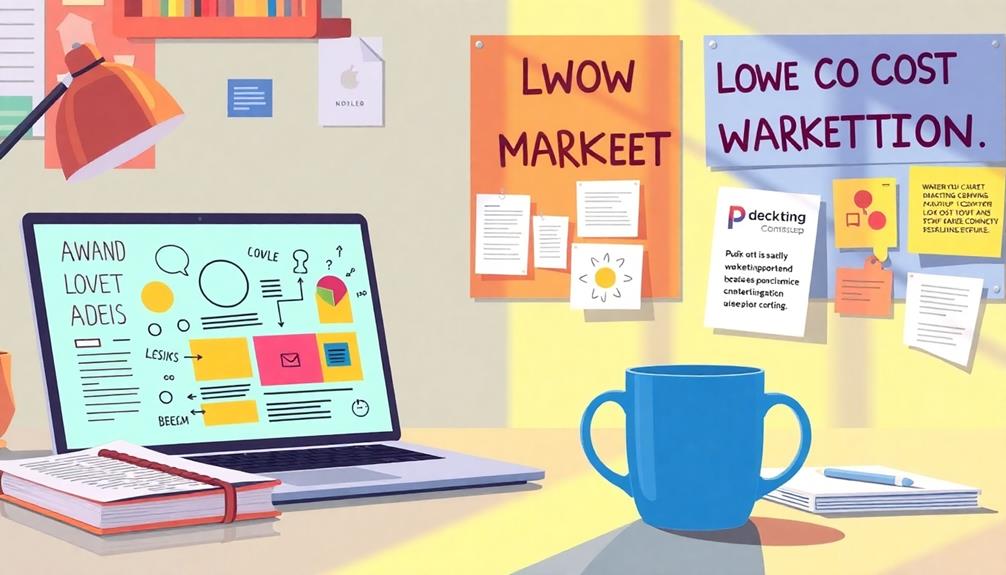
Many businesses find that cost-effective content marketing can be a game changer. By focusing on proven marketing strategies, you can generate three times more leads per dollar spent compared to paid search.
Regularly updating your blog with valuable content not only enhances your search engine optimization (SEO) but also boosts organic traffic without incurring extra advertising costs. In addition, collective positive energy in your community can amplify your marketing efforts, as shared visions foster greater engagement and collaboration.
Here are a few strategies to maximize your content marketing efforts:
- Repurpose existing content: Transform blog posts into infographics or videos to reach a wider audience while minimizing production expenses.
- Engaging storytelling: Captivate your audience with compelling narratives that build brand loyalty and encourage repeat visits.
- Utilize free tools: Leverage resources like Canva for design and Google Analytics for performance tracking to enhance your strategy without breaking the bank.
Networking for Growth

Cost-effective content marketing sets a strong foundation, but to truly elevate your business, you need to harness the power of networking. Attending local events and business meetups can lead to valuable connections; nearly 70% of professionals credit networking as a key factor in their career success.
Don't underestimate online platforms like LinkedIn, where over 61 million users hold senior-level positions. Expanding your reach through these channels can open doors to new opportunities. Additionally, understanding the emotional landscape of your networking interactions can help you navigate relationships more effectively, especially when dealing with individuals who may have navigating emotional volatility.
Collaborating with other businesses through cross-promotions not only enhances visibility but also taps into new audiences. In fact, 78% of marketers say partnerships considerably increase brand awareness.
Regularly participating in community events builds goodwill and boosts brand recognition—82% of consumers view companies that support local initiatives more favorably.
Lastly, seek mentorship opportunities. Studies show that 70% of mentored individuals report improved performance and satisfaction. By finding a mentor, you gain insights that can help you navigate challenges more effectively.
Embrace networking to create meaningful connections, collaborate with others, and invest in your growth. Your business can thrive when you leverage the power of relationships!
Utilizing Email Marketing

Email marketing can be a game-changer for your business, especially when you implement smart strategies to maximize its effectiveness.
By segmenting your email list, you can elevate your open rates by up to 14.32%. This targeted approach allows you to send personalized content that resonates with specific audience groups, leading to a remarkable 26% increase in open rates.
Additionally, using techniques from top online reputation companies can enhance your brand's credibility, making your emails even more impactful.
Furthermore, maintaining a clean email list guarantees you reach active recipients, enhancing your engagement metrics.
Automated email campaigns can save you up to 70% of the time usually spent on manual outreach, enabling you to communicate consistently without extensive resources.
Here are some key strategies to take into account:
- Segment your audience to tailor your messaging effectively.
- Incorporate personalized content to make your emails more engaging.
- Use clear calls to action to boost your click-through rates by up to 371%.
Community Involvement Opportunities

Building relationships with your community can be just as impactful as effective email marketing. By participating in local events like fairs and festivals, you can boost your brand visibility while connecting with potential customers.
In fact, 65% of consumers prefer to engage with brands that demonstrate community involvement. Sponsoring community initiatives enhances goodwill and can lead to a 50% increase in brand awareness, as people remember brands that support local causes.
Collaborating with local charities for mutual promotion allows you to reach new audiences. Studies show that 83% of consumers are more inclined to buy from companies that support charitable causes.
Engaging in volunteer activities can further build a positive brand image; 70% of millennials are willing to pay more for products from socially responsible companies.
Don't overlook community platforms like local social media groups and neighborhood apps. They can greatly broaden your outreach, with 80% of consumers more likely to support businesses active in their community.
Frequently Asked Questions
How to Market Your Small Business on a Shoestring Budget?
To market your small business on a shoestring budget, leverage free social media, create engaging content, utilize email campaigns, encourage customer referrals, and participate in community events to boost visibility and credibility without significant costs.
What Is a Good Budget for Marketing Strategy?
A good marketing budget typically ranges from 5% to 10% of your revenue. For startups, consider allocating 10% to 20% to effectively build brand awareness and reach your target audience. Adjust as needed based on results.
How Do You Market a Zero Budget?
You can market on a zero budget by leveraging social media, utilizing email marketing, encouraging customer referrals, creating valuable content, and collaborating with local businesses. These methods help you reach your audience effectively without spending money.
How to Effectively Market Your Business?
To effectively market your business, engage existing clients through personalized communication, leverage social media for valuable content, encourage referrals, and participate in local events to enhance visibility and build relationships. Consistency is key!
Conclusion
In a world where marketing budgets can feel tight, these proven strategies can help you thrive without breaking the bank. Imagine the buzz you'll create as your customers refer friends, engage with your social posts, and enthusiastically open your emails. By building strong connections and tapping into your community, you'll not only grow your brand but also foster loyalty. So, are you ready to transform your approach and watch your business flourish?
Business
Using Analytics to Improve Your Social Media Strategy
Improving your social media strategy with analytics can unlock insights you never knew existed, but what key metrics should you focus on?

Using analytics is essential for improving your social media strategy. You can track key metrics like engagement rates, reach, and conversion rates to gain insights into audience behavior. Tools such as Google Analytics and Sprout Social provide real-time data that helps you tailor your content for better engagement. By analyzing competitor strategies, you can identify gaps and refine your approach for maximum impact. Data-driven decisions increase your chances of meeting marketing goals considerably. With continuous testing and adjustment based on analytics, you'll see ongoing improvement in your social media presence. There's plenty more to explore to boost your strategy effectively.
Key Takeaways
- Utilize social media analytics tools like Sprout Social and Google Analytics to track engagement rates and audience demographics for tailored content strategies.
- Implement data-driven decisions to refine content, which can boost audience engagement by up to 20% and enhance ROI by 15%.
- Monitor key metrics such as conversion rates and audience growth rates to gauge the effectiveness of marketing strategies and optimize future campaigns.
- Conduct competitor analysis to identify performance gaps and adapt successful content strategies that resonate with your target audience.
- Continuously evaluate campaign effectiveness through engagement rates, reach, and unique promo codes to ensure ongoing optimization and improved results.
Understanding Social Media Analytics

Social media analytics is the key to revealing valuable insights about your audience. By collecting and analyzing data from various platforms, you can uncover how your audience interacts with your content, their preferences, and their behaviors. This understanding is essential for shaping effective marketing strategies.
Key metrics like engagement rates, reach, impressions, and conversion rates allow you to assess how well your content resonates with your audience. Additionally, understanding AI's role in cybersecurity can enhance your social media strategy by ensuring that your data is secure as you analyze it.
Using tools like Google Analytics and Sprout Social, you can track your social media performance in real-time. These insights help you identify trends and areas for improvement, ensuring your strategy remains effective.
A vital element of social media analytics is sentiment analysis, which enables you to gauge public perception and emotional responses to your brand. By examining user-generated content and interactions, you can better understand how your audience feels about your offerings.
With over 4.95 billion people using social media worldwide, this vast pool of data is an invaluable resource. Leveraging social media analytics not only enhances customer engagement but also drives informed business decisions that can lead to your brand's growth and success.
Importance of Data-Driven Decisions

Analyzing data from social media platforms not only uncovers audience insights but also highlights the significance of making data-driven decisions in your strategy. By leveraging social media analytics, you can tailor your content to perfectly align with your audience's preferences, leading to a remarkable 25% increase in customer satisfaction.
With the recent CrowdStrike outage affecting global operations, understanding your audience's needs through data becomes even more essential. When you implement these data-driven decisions, you're 60% more likely to achieve your marketing goals compared to those who don't utilize data insights.
Moreover, refining your content based on performance metrics can boost your audience engagement by up to 20%. This means that by understanding what resonates with your followers, you can create more engaging posts that keep them coming back for more.
Analytics-driven marketing strategies also enhance your return on investment (ROI) by 15%, as you allocate resources more efficiently based on proven interactions.
Real-time data analysis empowers you to adapt your strategies quickly, improving campaign performance by an average of 30%. By responding to emerging trends and audience sentiments, you guarantee that your social media efforts remain relevant and effective, ultimately driving your business success.
Key Metrics to Track
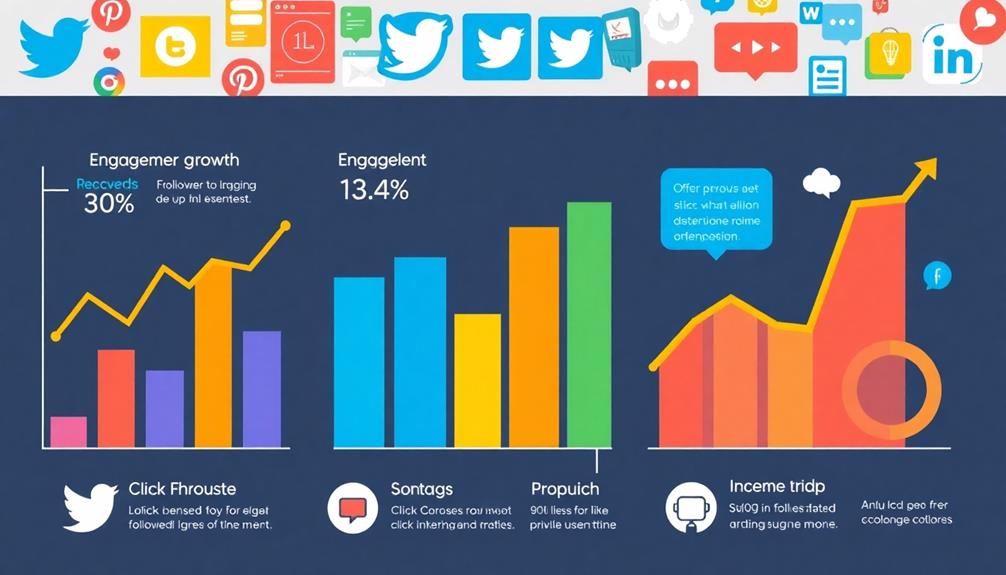
When it comes to optimizing your social media strategy, tracking the right metrics is essential. Start with the engagement rate, which measures how much your audience interacts with your content through likes, comments, and shares. A higher engagement rate means your content resonates well, building a stronger connection with your followers.
Additionally, leveraging data-driven marketing strategies can help you identify trends and tailor your content to better meet your audience's preferences.
Next, keep an eye on the audience growth rate. This metric indicates how quickly your following is expanding, calculated by the net new followers divided by your total followers at the beginning of the period. Understanding this rate helps you gauge the effectiveness of your growth strategies.
Don't forget about the conversion rate, too. This metric shows the percentage of users who complete a desired action, like making a purchase, after engaging with your content. Monitoring the conversion rate allows you to assess the success of your campaigns in driving sales and achieving your marketing goals.
Tools for Effective Analytics

To effectively measure and enhance your social media performance, leveraging the right analytics tools is essential. Social media analytics tools like Sprout Social provide in-depth insights, allowing you to track engagement metrics such as likes, shares, and comments across multiple platforms.
This information is vital for making data-driven strategy adjustments, much like how diversification strategy helps mitigate risk in investing.
Google Analytics is another powerful tool, helping you monitor website traffic originating from your social media channels. It offers insights into user behavior and conversion rates, which are important for evaluating your campaign's effectiveness.
Hootsuite aggregates performance data from various networks, giving you a centralized view that helps identify trends and optimize content strategies based on audience engagement.
If you prefer a user-friendly interface, Buffer allows you to analyze post performance metrics easily, refining your content and posting schedules to maximize reach and engagement.
Tools like Later and Rival IQ offer specialized features such as content previews and competitive analysis, ensuring thorough tracking and reporting.
Audience Insights and Segmentation
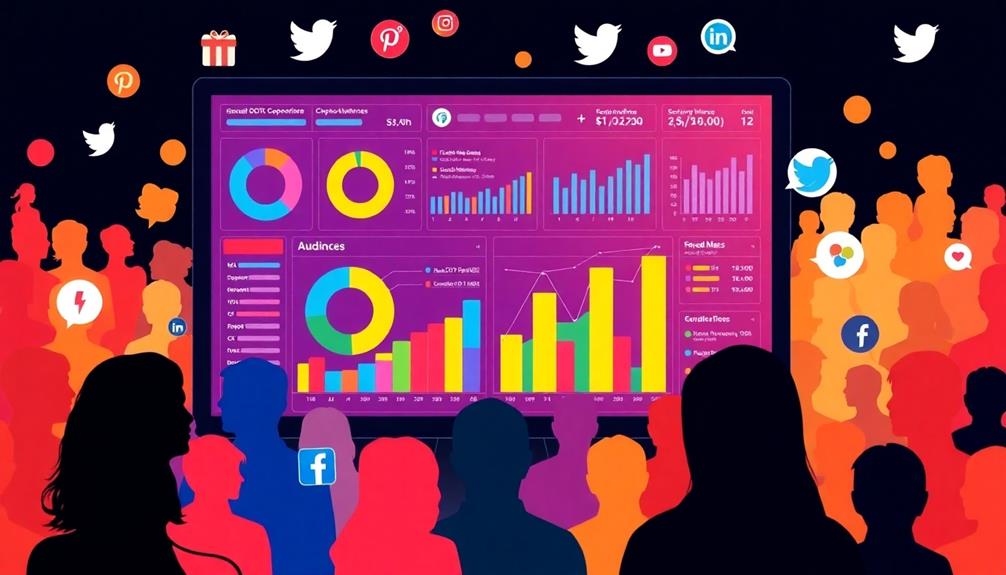
Understanding your audience is essential for crafting effective social media strategies. By diving into audience insights, you can tailor your content based on specific characteristics that resonate with your followers.
Emphasize gratitude to enhance professional growth and engagement. Here are four key aspects to reflect on:
- Audience Demographics: Analyze data such as age, gender, and location to understand who your audience is. This helps in creating content that appeals directly to them.
- Interests and Behaviors: Segment your audience based on their interests and online behavior. This allows you to develop personalized marketing strategies that speak directly to each group's unique preferences.
- Tools for Insights: Utilize platforms like Sprout Social to gather industry-specific information. These tools help refine your content strategies, ensuring they align with audience preferences.
- Continuous Monitoring: Keep an eye on engagement patterns to identify which content types drive the most interaction. This ongoing optimization can enhance your social media efforts considerably.
Competitor Analysis Techniques
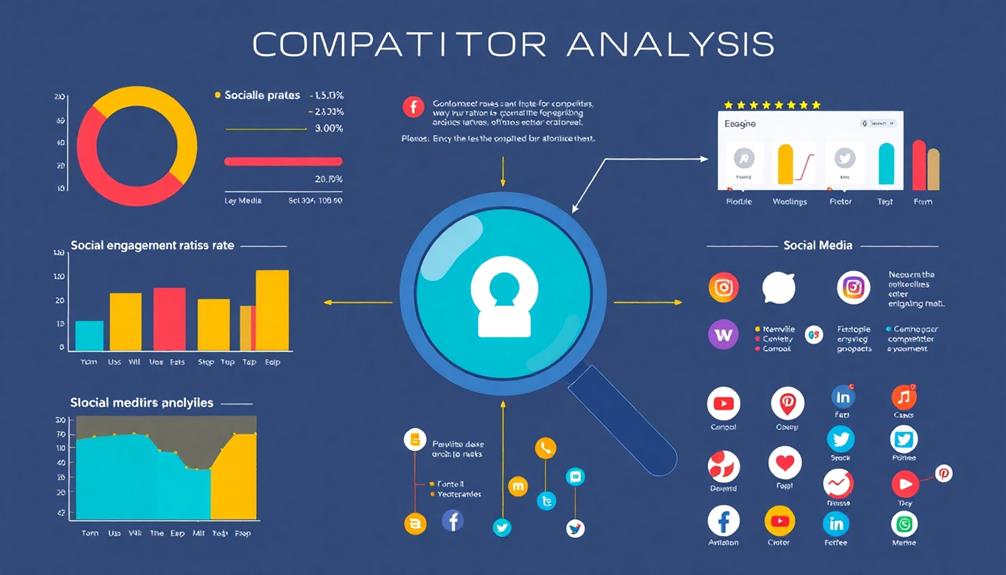
Competitor analysis techniques are essential for refining your social media strategy and gaining a competitive edge. By evaluating your competitors' follower counts and engagement rates, you can identify performance gaps and set realistic benchmarks for your growth. Tools like Sprout Social can help you consolidate this data across various networks, enabling you to compare your performance metrics against industry standards effectively.
Additionally, leveraging data analytics for targeted advertising can further enhance your understanding of successful strategies in your niche.
Take a close look at your competitors' content strategies, including their post frequency and the types of content they share. This examination can reveal what resonates with your target audience, allowing you to inform your own content creation efforts.
Additionally, monitoring audience demographics and engagement patterns will help you understand your competitors' strengths and weaknesses, letting you tailor your strategies to target untapped market segments.
Don't overlook the insights gained from evaluating your competitors' paid social campaigns. By analyzing their ad formats and engagement metrics, you can gather valuable information on successful tactics that you can adapt to optimize your advertising strategies for better ROI.
Embrace these competitor analysis techniques, and watch your social media strategy evolve and improve.
Paid Social Performance Metrics
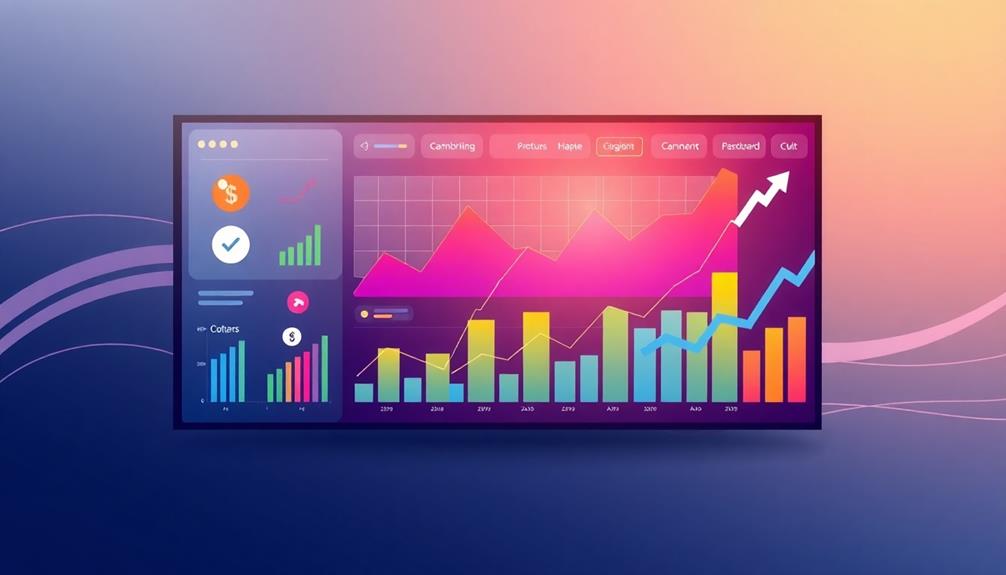
Measuring the effectiveness of your paid social campaigns is essential for optimizing your advertising efforts. Understanding paid social performance metrics helps you pinpoint what's working and what needs improvement.
For instance, analyzing your RMD strategies could provide insights into timing and distribution that parallel your social media efforts. Here are four key metrics to focus on:
- Click-Through Rates (CTR): This metric shows the percentage of users who clicked your ad after seeing it. An average CTR across platforms usually hovers around 2-3%.
- Cost-Per-Click (CPC): Knowing your average CPC, which for Facebook ads is about $1.72, helps you understand how much you're paying for each click on your ad.
- Conversion Rates: This determines the percentage of users who complete a desired action after clicking. A benchmark for e-commerce is around 2-5%, making it essential for evaluating campaign effectiveness.
- Engagement Metrics: Likes, shares, and comments on your ads provide insight into audience interaction. High engagement can greatly boost your campaign's reach and success.
Influencer Campaign Analytics

When you're running influencer campaigns, measuring engagement metrics is essential to understanding their impact.
Utilizing AI privacy protection can also enhance your data collection methods while ensuring user trust.
You'll want to evaluate influencer performance by tracking key indicators like reach and conversion rates.
Measuring Engagement Metrics
Engagement metrics are vital for evaluating the success of influencer campaigns. By focusing on these metrics, you can gain valuable insights into how well your content resonates with your audience.
Additionally, understanding strategies for building a loyal podcast audience can enhance your influencer marketing efforts. Here are four key engagement metrics to measure:
- Likes: Reflects immediate approval and interest in the content.
- Comments: Indicates deeper engagement and provides feedback directly from your audience.
- Shares: Shows how likely your content is to be spread within networks, enhancing brand visibility.
- Saves: Demonstrates that users find the content valuable enough to revisit later.
When analyzing audience demographics, you can tailor your campaigns to influencers who best connect with your target market. This step is essential for measuring ROI, as it allows you to track direct conversions through unique promo codes or affiliate links associated with influencers.
Additionally, monitoring hashtag usage can reveal patterns in audience interactions, helping you optimize future strategies. By focusing on these engagement metrics, you can refine your influencer marketing approach and drive better results for your brand.
Evaluating Influencer Performance
To effectively evaluate influencer performance, brands must analyze key metrics that reveal the impact of their campaigns. Start by tracking engagement rates, which include likes, comments, and shares per post. This data gives you insights into how well the audience responds to the influencer's messaging. High engagement rates often indicate that the content resonates with followers, enhancing your brand's visibility.
Additionally, exploring top platforms for influencer collaborations can provide a broader perspective on effective strategies within the industry.
Next, assess audience reach. Monitoring how many people see the influencer's posts helps you understand the potential exposure of your campaigns. Combining reach with engagement rates provides a clearer picture of overall effectiveness.
Don't forget to measure conversions generated from influencer campaigns. By using unique promo codes or affiliate links, you can accurately calculate the ROI from each influencer. This direct attribution of sales can greatly inform your future marketing strategies.
Lastly, compare the influencer's metrics against industry benchmarks. This comparison allows you to identify high-performing influencers and make data-driven decisions for optimizing future collaborations.
Tracking Campaign Effectiveness
As brands aim to maximize their marketing impact, tracking campaign effectiveness through influencer analytics becomes essential.
To effectively measure the success of your influencer partnerships, focus on these key metrics:
- Engagement Rates: Monitor likes, comments, and shares to understand how well your audience is interacting with the content.
- Reach: Analyze how many people see your influencer's posts, offering insight into brand visibility.
- Conversion Rates: Utilize unique promo codes to track sales directly attributed to each influencer, allowing for a clear ROI assessment.
- Hashtag Effectiveness: Review the performance of hashtags used during the campaign to gauge audience engagement levels and refine future strategies.
Testing and Iteration Strategies

Testing and iteration strategies are essential for optimizing social media performance. Start by implementing A/B testing, where you experiment with different content types, posting times, and audience segments. This approach helps you identify which combinations yield the highest engagement rates.
Utilize analytics tools to track and compare performance metrics from various test campaigns. This data-driven decision-making allows you to adjust your content strategy effectively.
Regularly analyze audience feedback and engagement data to refine your messaging. By understanding what resonates with your audience, you can optimize your content to better meet their preferences.
Foster a culture of experimentation within your team by encouraging members to propose and test new ideas based on analytical insights and emerging trends.
After each campaign, continuously iterate on your strategies by reviewing performance data. Ascertain that the lessons learned are applied to future social media efforts, which leads to ongoing improvement.
By embracing testing and iteration, you'll not only enhance your social media performance but also create a more engaging experience for your audience.
Real-World Case Studies

Now, let's look at how companies like Netflix, Coca-Cola, and Nike use social media analytics to boost their success.
You'll see how Netflix taps into viewer behavior for content recommendations.
Coca-Cola measures sentiment to shape its marketing.
Nike targets campaigns effectively to increase sales.
These real-world examples show the power of analytics in driving engagement and growth.
Netflix's Viewer Behavior Insights
Many viewers mightn't realize how deeply Netflix analyzes their watching habits to enhance the viewing experience. By leveraging viewer behavior insights, Netflix greatly personalizes recommendations, leading to improved user engagement and high retention rates.
Here are four key strategies they employ:
- Watch Patterns: Netflix tracks completion rates and viewing times to identify which genres and titles resonate with different demographics. This data guides their content acquisition and original programming decisions.
- A/B Testing: They conduct A/B tests on thumbnails and descriptions to maximize click-through rates. By tailoring visuals based on historical engagement data, Netflix captures attention effectively.
- Sentiment Analysis: Utilizing sentiment analysis from social media platforms, Netflix gauges audience reactions to new releases. This allows them to adjust marketing strategies and enhance viewer satisfaction.
- Interactive Content: Their analytics reveal that users engaging with interactive content, like "Bandersnatch," are more likely to return. This emphasizes the importance of innovative content formats in driving future engagement.
Through these methods, Netflix continuously refines its approach, ensuring that viewer behavior insights translate into a compelling and satisfying viewing experience.
Coca-Cola's Sentiment Analysis Strategy
Coca-Cola effectively harnesses sentiment analysis to gauge public reactions to its marketing efforts, guaranteeing that its messaging resonates with consumers. By analyzing social media conversations, you can see how Coca-Cola identifies emerging trends and consumer preferences. This allows the company to pivot its marketing strategies quickly, maintaining relevance in a fast-changing landscape.
Coca-Cola employs sentiment analysis tools to evaluate customer feedback on new product launches. This guarantees that their offerings align with consumer expectations and desires, leading to a more satisfied audience. By tapping into these customer insights, Coca-Cola creates personalized marketing content that speaks directly to their audience's sentiments.
Moreover, sentiment analysis plays a vital role in Coca-Cola's crisis management strategies. When negative perceptions arise, the company can address issues swiftly and effectively, protecting its brand reputation. This proactive approach not only mitigates potential damage but also fosters increased customer satisfaction and engagement.
Nike's Targeted Campaign Success
Nike's innovative approach to social media analytics has propelled its campaigns into the spotlight, demonstrating the power of targeted marketing. By analyzing customer engagement and preferences, Nike crafts tailored campaigns that resonate with specific audience segments.
Here are some key successes:
- "Dream Crazy" Campaign: Featuring Colin Kaepernick, this campaign led to a 20% increase in online sales shortly after launch.
- Diverse Demographics: Insights from audience analytics boosted Nike's follower engagement rate by 48% on Instagram, allowing them to connect with a wider audience.
- Positive Brand Sentiment: Through sentiment analysis, Nike adjusted strategies during the "You Can't Stop Us" campaign, resulting in a 10% increase in brand sentiment.
- Influencer Partnerships: By tracking influencer performance, Nike partnered with key figures, enhancing campaign reach and engagement by 27%.
Nike's commitment to using social media analytics not only drives engagement and conversion but also strengthens brand sentiment.
Their data-driven strategies, like A/B testing, lead to significant improvements, showcasing how analytics can transform your social media approach effectively.
Frequently Asked Questions
How Would You Use Social Media Analytics to Improve Your Social Media Strategy?
To improve your social media strategy, set SMART goals, identify key metrics, and leverage analytics tools. Analyze audience engagement and conduct competitor analysis to refine your content and enhance your overall performance effectively.
How Can Social Media Analytics Be Used in Content Strategy?
In today's digital jungle, you can harness social media analytics to pinpoint engaging content types, tailor messaging to your audience's preferences, and track performance metrics for ideal posting times, enhancing your overall content strategy.
How Are Analytics Used in Social Media?
Analytics in social media help you track user interactions, measure engagement, and assess content performance. By analyzing data, you can identify trends, understand your audience better, and refine your strategies for improved results.
How Can Social Media Analytics Benefit a Marketing Strategy?
You'll find social media analytics transforms your marketing strategy. It uncovers audience preferences, sharpens your messaging, and enhances engagement. By tracking performance, you can make informed decisions that boost your brand's visibility and drive growth.
Conclusion
Incorporating analytics into your social media strategy is like having a compass on a journey—it guides you toward success. By understanding key metrics and leveraging the right tools, you can make data-driven decisions that resonate with your audience. Don't shy away from testing and iterating; it's all part of refining your approach. With the insights you gain, you'll not only enhance engagement but also build a more effective and impactful social media presence.
Business
Go Pro With NLP: Advanced Techniques to Elevate Your Marketing
Incorporate cutting-edge NLP techniques to revolutionize your marketing strategies—discover how to engage your audience like never before.

To go pro with NLP and elevate your marketing, harness advanced techniques that refine your strategies. Leverage sentiment analysis to gauge customer emotions and tailor your messaging. Use NLP for hyper-personalized content that resonates with your audience, boosting engagement rates considerably. Implement behavior analysis to tweak your approach in real-time, maximizing relevance. Don't forget about SEO integration; optimizing your content helps you reach your target market effectively. By adopting these insights, you'll foster stronger connections and improve conversion rates. Discover even more game-changing techniques that can further optimize your marketing success.
Key Takeaways
- Utilize real-time sentiment analysis to gauge customer emotions and adjust marketing strategies for immediate impact.
- Implement advanced audience targeting through NLP to personalize messaging and boost engagement rates significantly.
- Leverage predictive analytics to forecast consumer behaviors, enhancing personalization and reducing churn effectively.
- Optimize content creation with NLP tools for tailored messaging, improving conversion rates and search engine visibility.
- Analyze behavioral patterns to dynamically adjust marketing approaches, ensuring relevance and higher customer engagement.
Understanding NLP Fundamentals

Natural Language Processing (NLP) is an indispensable technology that shapes how we interact with machines today. It enables machines to understand language, making it easier for you to communicate with them. At its core, NLP technology combines computer science, linguistics, and cognitive psychology to interpret and generate human language.
This capability is essential for creating applications like chatbots and voice recognition systems that enhance user experience. By utilizing data-driven marketing strategies, you can further refine how NLP is applied in your campaigns.
Key tasks within NLP include tokenization, part-of-speech tagging, and semantic analysis. These techniques help you grasp the structure and meaning of text, facilitating deeper insights into customer sentiment.
For instance, by analyzing customer feedback, you can pinpoint how your audience feels about your brand or product, allowing you to make informed decisions.
The evolution of NLP has greatly benefited from advancements in machine learning, particularly models like BERT, which improve context comprehension.
As you explore NLP fundamentals, you'll find that understanding these basic concepts is essential for leveraging its capabilities in your marketing strategies, enhancing audience targeting and content personalization.
NLP's Impact on Marketing

NLP transforms how you approach marketing by enhancing personalization strategies and enabling targeted content creation.
By leveraging advanced AI technologies, you can analyze vast amounts of customer data to tailor your messaging more effectively.
With real-time sentiment analysis, you can adjust your messaging to resonate with your audience's emotions instantly.
This powerful combination leads to more effective campaigns that truly connect with customers.
Enhanced Personalization Strategies
Harnessing advanced techniques in language processing can revolutionize how marketers engage with their audience. With NLP, you can analyze customer language patterns, allowing you to create hyper-personalized messaging that truly resonates with individual preferences and behaviors. This means you can craft messages that speak directly to your target audience, enhancing personalization in ways you mightn't have thought possible.
By implementing steps to authoritative content in your NLP strategies, you can guarantee that the content you create isn't only personalized but also highly relevant to your audience.
By segmenting your audience more effectively using nuanced interests identified through language use, you can improve your targeting precision. This leads to the delivery of relevant content that captures attention and drives engagement. In fact, personalized content generated through NLP can boost engagement rates by up to 50%.
When your messaging feels relevant and tailored, users are much more likely to respond positively.
Moreover, dynamic content personalization can lead to a 20% increase in conversion rates. Customers are more inclined to complete a purchase when they receive relevant product recommendations that align with their interests.
Real-Time Sentiment Analysis
Understanding consumer emotions in real-time can transform your marketing strategies considerably. By leveraging sentiment analysis powered by natural language processing (NLP), you can gauge customer feelings and opinions as they happen. This immediate insight allows you to adjust your campaigns dynamically, enhancing your responsiveness to customer needs.
With real-time sentiment analysis tools, you can tap into vast amounts of customer data from social media, reviews, and surveys. This analysis not only reveals public perception but also helps you identify emerging trends and potential issues in customer feedback before they escalate. The result? A more proactive approach to customer service.
Brands utilizing sentiment analysis have seen engagement increase by up to 30%, thanks to their ability to respond quickly to preferences and concerns. Moreover, integrating these insights into your marketing strategies can boost targeting and personalization efforts, potentially increasing conversion rates by as much as 20%.
In an era where voice recognition technology is becoming prevalent, combining it with sentiment analysis can additionally enhance your understanding of consumer emotions, ensuring your marketing strategies remain effective and relevant in real-time.
Targeted Content Creation
Targeted content creation is revolutionizing how marketers connect with their audiences, making it essential to leverage advanced technologies like natural language processing. By utilizing NLP, you can analyze customer language patterns to craft content that truly resonates with specific demographics. This isn't just about guessing what your audience wants; it's about understanding their language and preferences in-depth.
NLP enables you to perform sentiment analysis, allowing you to align your messages with current customer emotions. This approach markedly improves engagement rates, as you're speaking directly to what your audience feels.
Plus, using NLP tools helps generate optimized product descriptions and keywords, enhancing your visibility and driving organic traffic.
Personalization is another critical benefit of NLP. By tailoring content based on individual user interactions, you could see a reported 20% increase in conversion rates.
Additionally, leveraging NLP for competitive analysis allows you to identify trends and consumer sentiments around competitors, enabling you to adapt your content strategy for a competitive edge.
Incorporating NLP into your targeted content creation process can elevate your marketing efforts and foster stronger connections with your audience.
Advanced Audience Targeting

When it comes to advanced audience targeting, you can leverage demographic segmentation strategies, behavioral analysis techniques, and predictive analytics integration to sharpen your marketing efforts.
Demographic Segmentation Strategies
Demographic segmentation strategies empower marketers to connect with their audience on a deeper level by focusing on specific characteristics like age, gender, and income. By utilizing demographic segmentation, you can craft personalized messages that resonate with distinct groups. NLP aids in this process by analyzing language patterns in customer feedback and social media, allowing you to identify and target these segments effectively.
| Age Group | Preferred Content | Customer Service Expectations |
|---|---|---|
| 18-24 years | Engaging social media posts | Quick responses on platforms |
| 25-34 years | Informative blog articles | Personalized email communication |
| 35-50 years | Detailed product reviews | Extensive support options |
Research shows that targeted campaigns based on demographic segmentation can boost engagement rates by up to 300%. Advanced NLP techniques, like sentiment analysis, enable you to gauge emotional responses, tailoring your content marketing strategies. By leveraging these insights, you can optimize your marketing budget and focus on the most responsive audience segments, ensuring improved ROI and customer satisfaction.
Behavioral Analysis Techniques
Understanding consumer behavior is essential for effective marketing, as it allows you to tailor your strategies to meet the needs and preferences of your audience. By employing behavioral analysis techniques, you can leverage machine learning algorithms to identify and predict consumer behavior patterns based on historical data. This enables you to segment your audience more precisely.
Analyzing user interactions—like website navigation and social media engagement—helps you craft messaging that resonates with specific segments, boosting relevance and engagement rates. Additionally, sentiment analysis plays a vital role in evaluating customer feedback and reviews, providing insights into public sentiment towards your products or brand. This information guides your marketing strategies effectively.
Advanced behavioral targeting can enhance your click-through rates by up to 50% by delivering personalized content that aligns with individual consumer preferences and behaviors.
Integrating real-time data analytics allows you to dynamically adjust your campaigns based on live consumer behavior. This optimization not only improves performance but also maximizes your return on investment (ROI).
Predictive Analytics Integration
Harnessing predictive analytics can transform your audience targeting strategies by forecasting customer behaviors and preferences with remarkable accuracy. By leveraging historical data and machine learning algorithms, you can identify patterns in consumer interactions that reveal high-value segments. This allows you to create focused marketing campaigns that resonate with your audience's needs.
Integrating predictive analytics with NLP takes your strategies a step further. By interpreting user sentiment in real-time, you can craft personalized marketing experiences that engage customers more effectively. Businesses that adopt predictive analytics often see conversion rates increase by up to 20%, thanks to improved targeting and engagement.
Moreover, implementing predictive models can greatly reduce customer churn. By identifying at-risk customers early, you can intervene with timely strategies that encourage loyalty and retention. Imagine the impact on your bottom line if you could keep more customers happy and engaged.
Incorporating predictive analytics into your marketing toolkit not only enhances your audience targeting but also fosters deeper connections with your customers.
Embrace these advanced techniques to elevate your marketing game and drive measurable results.
Content Optimization Techniques

Effective content optimization techniques are essential for capturing audience attention and driving engagement in today's competitive digital landscape. By harnessing NLP, you can enhance your content optimization strategies considerably. Start by incorporating targeted keywords that resonate with your audience. This approach can boost your click-through rates by up to 20%, ensuring your content stands out.
Utilizing sentiment analysis tools powered by NLP allows you to tailor your content's tone and messaging in real-time, adapting to audience reactions. This responsiveness fosters deeper connections with your readers.
Additionally, automated content generation via NLP technologies can cut the time spent on crafting product descriptions by 50%, helping you launch products faster.
Don't forget the importance of SEO. Integrating NLP techniques into your SEO strategies can improve your search engine rankings, as Google prioritizes content that aligns with user intent.
Enhancing Customer Engagement

Enhancing customer engagement through advanced NLP techniques can transform how businesses interact with their audiences. By utilizing an NLP model, you can analyze customer interactions in real-time, allowing for prompt and effective responses to inquiries. This responsiveness can boost your engagement rates by up to 50%.
Moreover, leveraging sentiment analysis enables you to understand your customers' emotions better. By tailoring your marketing messages to resonate with these sentiments, you can achieve a 20% increase in customer satisfaction.
Personalized experiences are key to fostering deeper connections with your audience. By harnessing NLP-driven insights, you can create content that speaks directly to individual preferences, resulting in a 15% boost in repeat purchases and long-term loyalty.
Implementing chatbots powered by NLP further enhances engagement. These systems provide 24/7 customer support, greatly reducing response times and increasing engagement by up to 40%.
Leveraging Sentiment Analysis

Understanding your customers' emotions can greatly refine your marketing strategies. By leveraging sentiment analysis, you can gain real-time insights into how your audience feels about your products and brand.
This powerful tool uses NLP techniques to evaluate the emotional tone behind words, enabling you to craft effective marketing messages tailored to customer sentiments.
Here are some key benefits of incorporating sentiment analysis into your marketing:
- Identify positive, negative, or neutral sentiments in customer feedback.
- Personalize marketing messages based on the emotional state of your audience.
- Engage with customers in a timely and relevant manner.
- Enhance customer satisfaction by 20% through targeted strategies.
- Utilize advanced sentiment analysis models like BERT for improved accuracy.
Integrating NLP With SEO
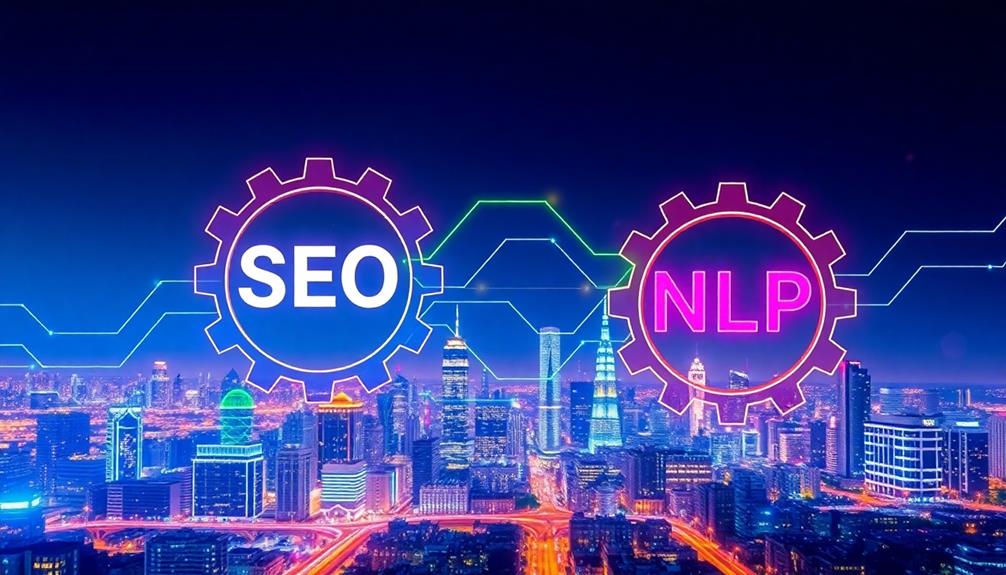
Integrating NLP with SEO transforms how you approach online visibility and content strategy. By leveraging NLP algorithms, like Google's BERT, you can optimize keyword research, identifying synonyms and related phrases that enhance your content's relevance and search visibility. This allows your strategy to align more closely with user intent, ensuring that search engines recognize the context behind queries.
Utilizing sentiment analysis through NLP also empowers you to gauge audience reactions to your content. This insight lets you make real-time adjustments to your SEO strategies, enhancing engagement and response rates.
Additionally, by analyzing user-generated content, NLP can reveal trending topics and common questions, guiding your content creation to resonate with current audience interests.
Implementing NLP tools can greatly boost your on-page SEO. These tools generate keyword-rich suggestions for essential elements like meta descriptions and title tags, ensuring they resonate with your target demographics.
Future Trends in NLP Marketing

As you look to the future of NLP marketing, the landscape is rapidly evolving with technology advancements that promise to reshape how brands connect with consumers.
NLP has become an integral part of digital marketing strategies, enabling personalized experiences that resonate with individual preferences.
Here are some key trends to watch:
- AI-driven NLP tools will see a market growth of over 20% annually, enhancing personalization.
- Advanced sentiment analysis will help brands tailor communications, as 72% of consumers prefer personalized messages.
- Voice search optimization is essential, with projections indicating that 55% of households will own smart speakers by 2025.
- Real-time customer insights will allow brands to adjust their strategies based on immediate feedback and trends.
- Data privacy compliance will rely on NLP to guarantee ethical usage and maintain consumer trust.
Frequently Asked Questions
What Is NLP in Marketing?
NLP in marketing involves using algorithms to analyze customer language, helping you tailor messaging and enhance engagement. It allows for personalized strategies, sentiment analysis, and improved customer interactions through automated solutions like chatbots, optimizing your marketing efforts.
What Is Advanced NLP?
Advanced NLP refers to sophisticated techniques that enhance language understanding through deep learning models. You can leverage these methods for sentiment analysis, automated content generation, and improved customer interactions, making your marketing strategies more effective and engaging.
How Can NLP Be Used to Improve Customer Feedback Analysis?
Imagine a magnifying glass revealing hidden gems in customer feedback. You can use NLP to extract sentiment scores, categorize themes, and pinpoint specific opinions, transforming raw data into actionable insights that enhance your product offerings.
How to Use Natural Language Processing (Nlp) for Modern SEO?
You can use NLP to enhance modern SEO by analyzing user intent, optimizing for voice search, automating meta descriptions, and leveraging sentiment analysis. This'll help you create content that truly resonates with your audience.
Conclusion
Incorporating NLP into your marketing strategy isn't just an option; it's a game changer. By mastering audience targeting, optimizing content, and enhancing engagement, you're not just keeping pace—you're setting the pace. Embrace sentiment analysis, integrate with SEO, and stay ahead of future trends. As you elevate your marketing, remember: the more you know, the more you grow. So, plunge into, explore, and transform your approach—because the future of marketing is powered by NLP.
Business
How to Use Scarcity and Urgency in Your Marketing
Discover strategies to leverage scarcity and urgency in your marketing, but beware—missteps can lead to lost trust and missed opportunities.

To effectively use scarcity and urgency in your marketing, emphasize limited availability and time-sensitive offers. Phrases like "only a few left" and "offer ends soon" can create a fear of missing out (FOMO). Implement countdown timers to visually push consumers towards immediate decisions. Low stock alerts also prompt quicker purchases by triggering psychological responses. Remember, authenticity matters; guarantee your claims of scarcity reflect genuine demand to maintain trust. When you combine these tactics with strong calls-to-action and social proof, you'll boost your conversion rates considerably. Explore more strategies to maximize your marketing effectiveness.
Key Takeaways
- Use limited-time offers and flash sales to create a sense of urgency for immediate purchasing decisions.
- Implement countdown timers on product pages to visually signal urgency and encourage quick action.
- Highlight low stock alerts to tap into consumers' fear of missing out, prompting faster purchases.
- Leverage social proof to enhance perceived value and urgency, such as showcasing items in multiple carts.
- Balance scarcity tactics with authenticity to maintain customer trust and loyalty over time.
Understanding Scarcity and Urgency

When it comes to marketing, many people underestimate the power of scarcity and urgency. These concepts serve as powerful psychological triggers that can markedly influence consumer behavior.
Scarcity marketing taps into your fear of missing out (FOMO) by creating a sense of limited availability. For instance, promoting a Gold IRA rollover as a limited-time opportunity can elevate its appeal and urgency. When you see phrases like "only a few left in stock," it heightens the perceived value of a product and prompts quicker buying decisions. You're more likely to act fast because you don't want to lose out on something others might grab.
On the other hand, urgency marketing drives immediate action through time constraints. When you encounter offers labeled as "limited time only," it stirs emotional responses that can lead to impulsive purchases.
Research shows that effective scarcity tactics can boost conversion rates by over 20%, making them invaluable in e-commerce and promotional campaigns. Both scarcity and urgency leverage psychological principles like loss aversion, pushing you to prioritize purchasing decisions that you might otherwise postpone.
Psychological Effects on Consumers

When you encounter scarcity in marketing, it triggers loss aversion, making you more likely to act quickly to avoid missing out.
This is particularly relevant in digital marketing, where free SEO keywords acquisition can create a sense of urgency for consumers to take action.
The fear of missing out (FOMO) can push you toward impulse buying, especially when time-sensitive offers are involved.
Understanding these psychological effects can help you recognize how marketing strategies influence your decisions.
Loss Aversion Influence
Loss aversion plays an essential role in how you make purchasing decisions, often pushing you to act quickly to avoid missing out. This psychological principle explains why you're more likely to respond to scarcity marketing strategies. When you perceive that a product is in limited supply, the fear of losing it becomes more powerful than the excitement of gaining something new.
Here's how loss aversion influences your choices:
| Factor | Effect on Consumer Behavior | Example |
|---|---|---|
| Limited Availability | Heightened urgency | "Only 2 left in stock!" |
| Time Constraints | Quick decision-making | "Offer ends in 24 hours!" |
| Emotional Response | Increased likelihood to purchase | "Don't miss out!" |
| Sensitivity to Loss | Acting to avoid regret | "Last chance to buy!" |
| Conversion Rates | Boosted by urgency tactics | "Grab yours before it's gone!" |
Impulse Buying Triggers
Scarcity and urgency not only tap into loss aversion but also trigger impulse buying behaviors that can greatly impact your shopping experience. When you encounter scarcity tactics, like limited-time offers or low stock alerts, you're likely to feel a heightened sense of desire for the product. This feeling makes you more prone to act quickly, driven by the fear of missing out (FOMO).
Just as in financial planning, where the timely management of resources is essential, recognizing the importance of planning ahead can enhance your decision-making process.
Urgency marketing tactics, such as countdown timers, create a pressing need for you to decide fast. Research shows these tactics can boost conversion rates by up to 12.7%, compelling you to make that purchase before it's too late.
Flash sales, lasting anywhere from 2 to 36 hours, often see up to 75% of Americans making spontaneous buys, illustrating just how powerful these triggers can be.
Moreover, highlighting social proof—like showing that an item is in multiple carts or has been recently purchased—reinforces the idea that the item is highly desirable. This not only validates your interest but also pushes you toward impulse buying, making you feel you need to act now to secure that sought-after item.
Embrace these impulse triggers to enhance your marketing strategies effectively.
FOMO Activation Strategies
As consumers encounter limited-time offers or dwindling stock alerts, they often feel an intense wave of anxiety driven by the fear of missing out (FOMO). This powerful psychological trigger can lead you to make impulsive purchasing decisions when you perceive scarcity and urgency.
Research shows that 60% of consumers are more likely to buy a product if they believe it's in limited supply. This feeling of potential loss pushes you to act quickly, prioritizing immediate action over deliberation. Strategies such as creating a sense of exclusivity—like offering a limited edition product—can further enhance this effect, especially in niche markets where consumers seek unique items increased interest in alternative investments amid market volatility.
Effective FOMO activation strategies include limited-time offers and low stock notifications. These tactics can boost conversion rates by over 20%, proving their significant impact.
Additionally, incorporating social proof—like showing how many people are viewing or purchasing an item—can further amplify FOMO. This creates a sense of competition among potential buyers, enhancing the urgency to act.
Boosting Conversion Rates
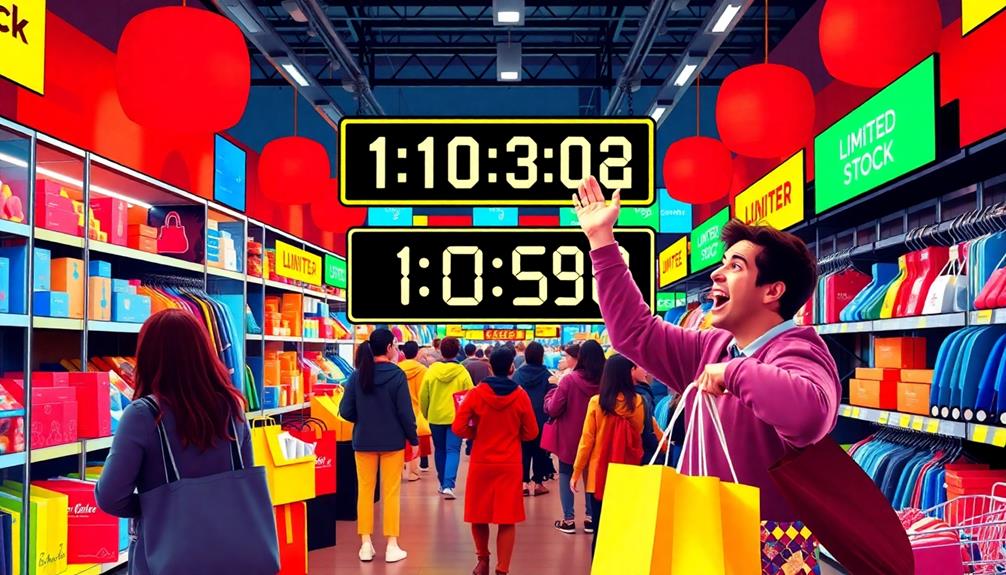
To boost your conversion rates, consider implementing time-sensitive offers, low stock alerts, and countdown timers in your marketing strategy.
These tactics create a sense of urgency that encourages customers to act quickly, reducing the chances of them walking away.
For instance, utilizing 10 Proven Ways Students Can Make Money Online can also enhance your promotional strategies.
When shoppers feel they might miss out, they're more likely to complete their purchase right away.
Time-Sensitive Offers
Time-sensitive offers create an electrifying atmosphere that can markedly boost your conversion rates.
These offers instill a sense of urgency, prompting consumers to act quickly before they miss out. By implementing strategies like these, businesses can guarantee they maximize their marketing effectiveness and drive immediate sales.
For example, creating a sense of urgency in financial decisions can mirror the importance of setting up a retirement savings plan effectively.
Here's how you can leverage time-sensitive offers effectively:
- Flash Sales: Host limited-time sales lasting anywhere from 2 to 36 hours. Research shows that 75% of Americans make impulse buys during these events, so make your offer irresistible!
- Countdown Timers: Use countdown timers on your website or in emails. Studies indicate that these can increase conversion rates by up to 9% as they create a visual urgency that compels action.
- Compelling Language: Incorporate phrases like "Offer ends soon" or "Today only" in your marketing messages. This simple adjustment can enhance urgency perception and encourage quicker decision-making.
Low Stock Alerts
When you highlight low stock alerts in your marketing, you're tapping into a powerful psychological trigger that can greatly enhance your conversion rates. These alerts create a sense of urgency, prompting customers to make quicker purchasing decisions to avoid missing out on limited products.
Research shows that displaying low stock notifications can lead to a 20% increase in sales, as consumers perceive scarcity as a signal of higher product value. This tactic mirrors the emotional dynamics seen in personal relationships, where the importance of clear communication during a breakup can facilitate smoother changes.
By highlighting that only a few items are left in stock, you can trigger FOMO (Fear of Missing Out), encouraging customers to act fast before the opportunity slips away. Effective low stock alerts not only create urgency but also capitalize on social proof. Messages like "Only 3 left in stock" validate consumer choices and can push hesitant buyers to complete their purchases.
Integrating low stock alerts into your marketing strategy—whether on product pages or during the checkout process—can considerably reduce cart abandonment rates, which currently hover around 70% for online retailers.
Countdown Timers
Countdown timers pack a punch in marketing by visually signaling urgency and driving immediate action from customers. When you implement countdown timers, you're not just creating a sense of scarcity; you're also boosting your conversion rates considerably.
Research shows that popups featuring countdown timers convert 113% better than those without. That's a game changer! Additionally, integrating countdown timers can enhance user experience and improve overall site performance, aligning with SEO and UX strategies.
Here are three effective ways to use countdown timers:
- Above the "Add to Cart" Button: This placement grabs attention and encourages quicker purchasing decisions.
- In Marketing Emails: Including countdown timers can improve open rates by 14% and transaction rates by 16%, effectively driving customer engagement.
- Alongside Limited-Time Offers: Pairing countdown timers with special deals creates a compelling urgency that motivates customers to act fast.
Best Practices for Implementation
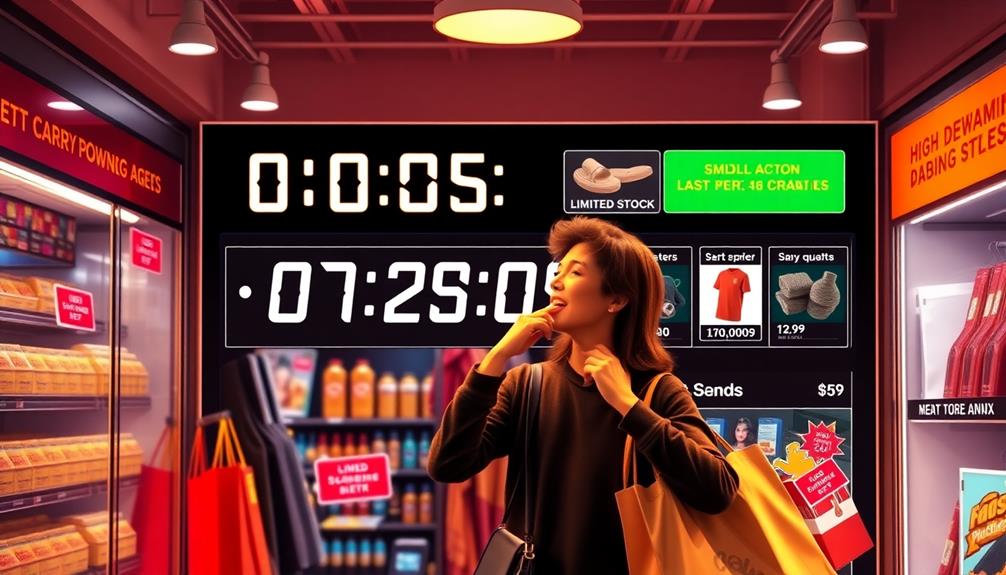
Implementing scarcity and urgency in your marketing strategy can greatly boost customer engagement and conversion rates. Start by using clear and honest messaging about product availability and time limits. This builds brand credibility and avoids customer distrust.
Just as in relationship dynamics, effective communication is essential for avoiding misunderstandings and fostering trust recognizing signs of stagnation.
Utilize countdown timers on product pages and in marketing emails; they can visually represent urgency and increase conversions by up to 113%.
Highlight low stock levels with alerts like "Only 2 left in stock!" to create a sense of urgency that prompts quicker purchasing decisions. When you combine scarcity tactics with quality assurance, you enhance the overall appeal of your offerings.
Make sure your calls-to-action are strong, emphasizing the benefits of immediate action.
Regularly test different urgency tactics and observe consumer responses to identify the most effective strategies. This ongoing optimization can considerably enhance your engagement and boost conversions.
Real-Life Marketing Examples

As you explore the effectiveness of scarcity and urgency in marketing, consider how real companies have harnessed these strategies to drive results.
The principles of Web 3.0 can also be applied to create unique marketing experiences that engage users in new ways. Here are three powerful examples:
- Booking.com utilizes real-time information, showcasing that others are booking accommodations. This display of urgency encourages potential customers to make quicker decisions, reducing the chances of losing out on their desired stay.
- OnePlus employs an invite-only purchasing model, creating scarcity marketing that heightens the perceived value of their products. Tech enthusiasts feel a sense of exclusivity, driving demand and excitement around each product launch.
- Sushi Shop implemented urgency tactics through limited-time promotions, resulting in a 3% increase in order confirmations. The time-sensitive nature of their offers prompts customers to act fast, boosting overall sales.
These examples demonstrate how effectively leveraging scarcity and urgency can lead to impressive results.
Whether it's through real-time information or exclusive offers, each company has successfully created a sense of urgency that compels customers to engage and purchase sooner rather than later.
Effective Ecommerce Strategies
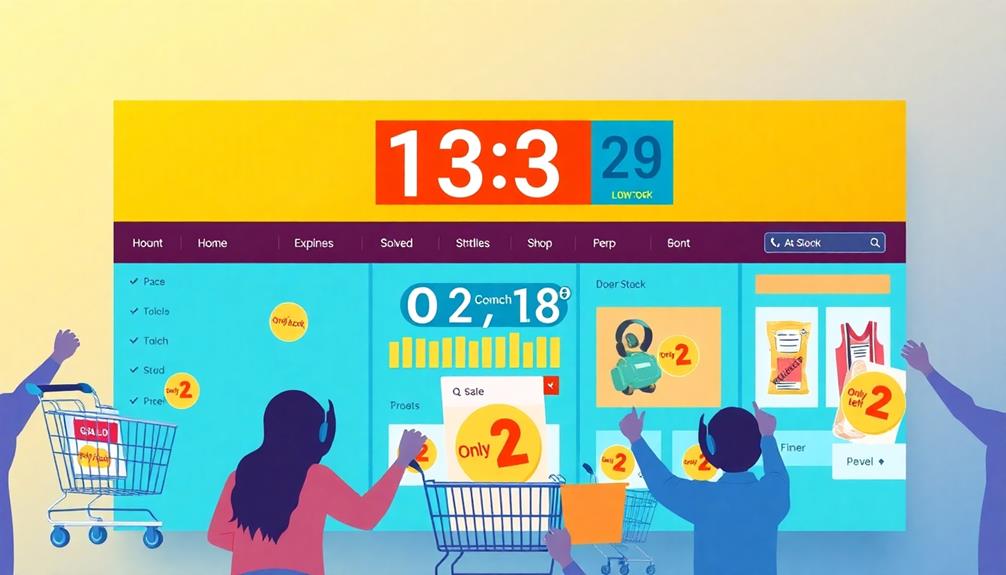
Harnessing scarcity and urgency isn't just effective for individual campaigns; it's also a key component of successful ecommerce strategies. By employing the scarcity principle, you can create an environment where customers feel compelled to act quickly.
Implement flash sales lasting from 2 to 36 hours to ignite excitement. These events can lead to spontaneous purchases, with 75% of Americans likely to buy during them.
Incorporate urgency tactics like countdown timers on your product pages and in marketing emails. This simple addition can enhance your conversion rates by up to 113%, pushing customers to make immediate decisions.
Highlight low stock levels by displaying remaining inventory, using phrases like "Only a few left!" to prompt quicker purchases.
Social proof is another powerful tool; show how many people are currently viewing a product or have recently bought it. This creates a sense of urgency and increases the perceived value of your offerings.
Finally, leverage limited-time offers with clear expiration dates, as these promotions rely heavily on the scarcity principle to drive consumer action.
Creating Authentic Scarcity

Creating authentic scarcity is essential for building trust with your customers. When you genuinely limit product availability, you create not just urgency but also a heightened perceived value.
Here are three ways to implement authentic scarcity effectively:
- Real-time inventory updates: Let your customers know when stock is low. This transparency fosters trust and creates an urgent situation that encourages quicker purchasing decisions.
- Seasonal or limited edition releases: Clearly communicate the reasons for scarcity. Whether it's a holiday special or a unique product drop, providing context enhances credibility and makes your offerings more desirable.
- Exclusive offers: Implement limited-time promotions that are genuinely scarce. This not only increases perceived value but also allows customers to feel part of an exclusive group.
However, be cautious not to overuse these tactics. Research shows that 73% of shoppers may lose loyalty if they frequently encounter out-of-stock items.
Balancing your approach guarantees that your scarcity tactics remain effective and trusted, leading to satisfied customers who appreciate the urgency you create.
Leveraging Social Proof
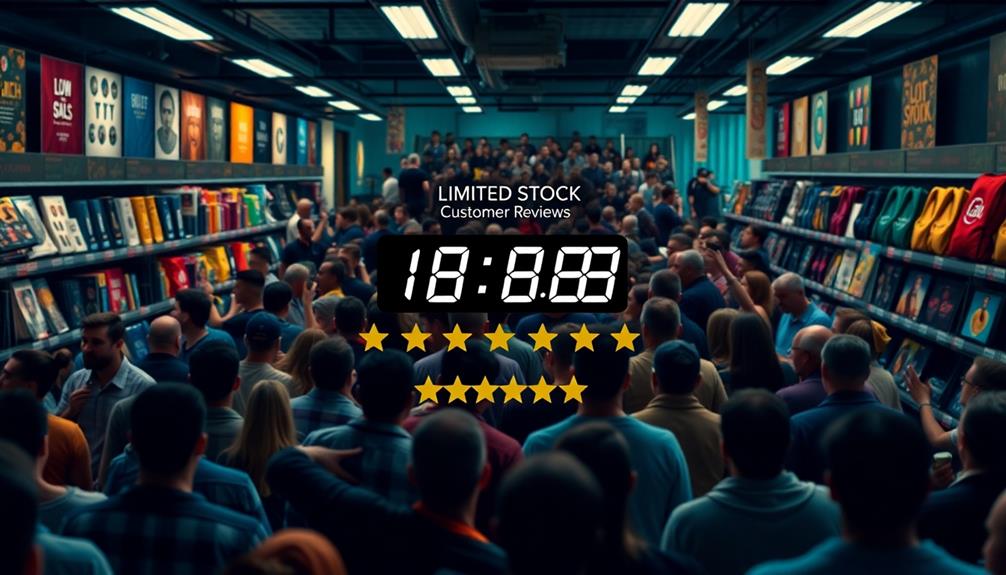
Leveraging social proof can considerably enhance your marketing strategy by instilling a sense of urgency in potential buyers. When you display customer reviews and ratings, you tap into a powerful motivator; in fact, 35% of shoppers trust online reviews as much as personal recommendations.
This trust can drive immediate purchasing decisions, especially when you highlight product popularity. Phrases like "X people are viewing this item" or "X units sold" create a competitive atmosphere, pushing customers to act quickly before the item is gone.
Testimonials from satisfied customers reinforce this effect by boosting buyer confidence. When others share positive experiences, consumers feel more secure in their choices.
To amplify urgency, integrate social proof with scarcity tactics, such as limited stock notifications next to customer reviews. This combination heightens the urgency and can considerably improve your conversion rates.
Using tools like Judge.me allows you to easily collect and display customer reviews, effectively turning social proof into a catalyst for urgency. By showcasing the popularity of your products alongside positive feedback, you encourage potential buyers to act swiftly, fearing they might miss out on something that's in high demand.
Balancing Urgency and Trust
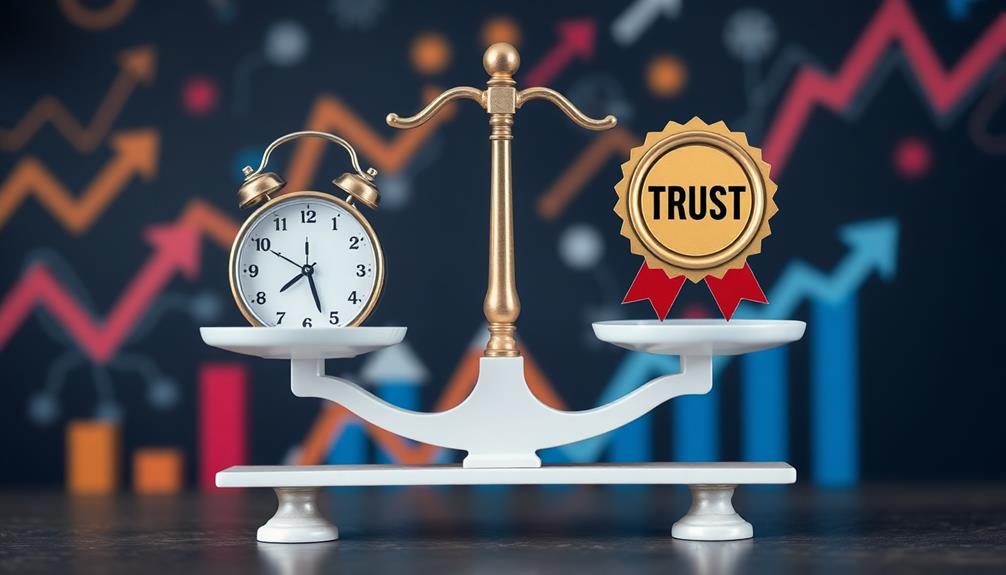
Balancing urgency and trust is vital for effective marketing. You want to create a sense of urgency through scarcity marketing, but it's important to do so without compromising customer trust. Misleading scarcity can lead to brand loyalty issues, so authenticity is key.
Here are three ways to strike that balance:
- Be Transparent: Clearly communicate stock levels. Research shows that 60% of consumers prefer brands that are honest about availability, which builds trust.
- Focus on Genuine Demand: Guarantee your urgency tactics reflect actual product demand. Exaggerated claims can create customer fatigue, undermining future marketing efforts.
- Integrate Value-Driven Offers: Combine urgency with genuine value. Instead of solely relying on scarcity, offer promotions that resonate with your audience's needs, enhancing overall brand perception.
Frequently Asked Questions
How Scarcity and Urgency Might Be Used as a Marketing Technique?
Scarcity and urgency create excitement in consumers. When you highlight low stock levels or limited-time offers, it pushes them to act quickly, tapping into FOMO and increasing the likelihood they'll make a purchase.
What Is an Example of Scarcity and Urgency?
When you see a limited edition item with only 100 pieces, or a sale that ends tonight, you feel compelled to act. You don't want to miss out on exclusive deals or significant savings!
What Is the Urgency and Scarcity Technique to Influence?
Urgency and scarcity techniques influence your decisions by creating a sense of immediacy. When you perceive limited time or availability, you're more likely to act quickly, fearing you might miss out on something valuable.
How Do You Use Scarcity in a Sentence Marketing?
You can effectively use scarcity in a sentence by saying, "Only two left in stock! Don't miss out on this exclusive offer—act now before it's gone!" This creates urgency and encourages quick decision-making.
Conclusion
Incorporating scarcity and urgency in your marketing is like setting the stage for a thrilling movie—draw in your audience, build anticipation, and keep them on the edge of their seats. Just like a limited-time offer can spark excitement, a well-timed countdown can push hesitant shoppers to act. Remember, when consumers feel the pressure of missing out, they're more likely to grab that deal. Use these techniques wisely, and watch your conversion rates soar!
-

 Vetted1 week ago
Vetted1 week ago11 Best Gore Websites to Explore the Darker Side of the Internet
-

 Vetted3 weeks ago
Vetted3 weeks ago15 Best Concrete Crack Fillers for a Smooth and Durable Finish
-

 Vetted3 weeks ago
Vetted3 weeks ago15 Best Insecticides to Keep Your Home Bug-Free and Safe
-

 Vetted3 weeks ago
Vetted3 weeks ago15 Best Car Air Fresheners to Keep Your Ride Smelling Fresh and Clean
-

 Vetted2 weeks ago
Vetted2 weeks ago15 Best Soldering Irons for Your DIY Projects – Top Picks and Reviews
-

 Vetted4 weeks ago
Vetted4 weeks ago15 Best Drywall Anchors for Secure and Hassle-Free Wall Mounting
-

 Vetted3 weeks ago
Vetted3 weeks ago15 Best Driveway Sealers to Protect Your Asphalt or Concrete Surface
-

 Vetted3 weeks ago
Vetted3 weeks ago15 Best Cordless Pool Vacuums for Effortless Pool Maintenance













